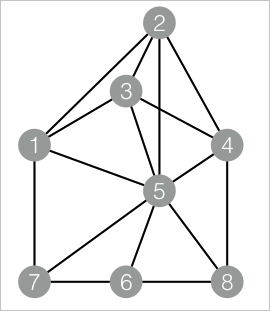エッジクラスタリング係数は、無向グラフにおけるエッジの密度の尺度である。 エッジクラスタリング係数コンポーネントは、各エッジ上の各頂点の隣接する頂点の数とエッジ密度を提供できます。
コンポーネントの設定
方法1: パイプラインページでコンポーネントを設定する
Edge Clustering Coefficientコンポーネントは、Platform for AI (PAI) コンソールのMachine Learning Designerのパイプラインページに追加できます。 下表に、各パラメーターを説明します。
タブ | パラメーター | 説明 |
フィールド設定 | Vertexを開始 | エッジテーブルの開始頂点列。 |
エンド頂点 | エッジテーブルの末尾の頂点列。 | |
チューニング | 労働者 | 並列ジョブ実行の頂点の数。 並列性とフレームワーク通信コストの程度は、このパラメータの値とともに増加します。 |
Workerあたりのメモリサイズ (MB) | 1つのジョブで使用できるメモリの最大サイズ。 単位:MB。 デフォルト値: 4096 使用済みメモリのサイズがこのパラメーターの値を超えると、 | |
データ分割サイズ (MB) | データ分割サイズ。 単位:MB。 デフォルト値: 64。 |
方法2: PAIコマンドを使用してコンポーネントを構成する
エッジクラスタリング係数コンポーネントは、PAIコマンドを使用して設定できます。 SQLスクリプトコンポーネントを使用してPAIコマンドを実行できます。 詳細については、「SQLスクリプト」トピックの「シナリオ4: SQLスクリプトコンポーネント内でPAIコマンドを実行する」をご参照ください。
PAI -name EdgeDensity
-project algo_public
-DinputEdgeTableName=EdgeDensity_func_test_edge
-DfromVertexCol=flow_out_id
-DtoVertexCol=flow_in_id
-DoutputTableName=EdgeDensity_func_test_result;パラメーター | 必須 | デフォルト値 | 説明 |
inputEdgeTableName | 可 | デフォルト値なし | 入力エッジテーブルの名前。 |
inputEdgeTablePartitions | 不可 | フルテーブル | 入力エッジテーブルのパーティション。 |
fromVertexCol | 可 | デフォルト値なし | 入力エッジテーブルの開始頂点列。 |
toVertexCol | 可 | デフォルト値なし | 入力エッジテーブルの末尾の頂点列。 |
outputTableName | 可 | デフォルト値なし | 出力テーブルの名前。 |
outputTablePartitions | 不可 | デフォルト値なし | 出力テーブルのパーティション。 |
ライフサイクルの設定 (Set lifecycle) | 不可 | デフォルト値なし | 出力テーブルのライフサイクル。 |
workerNum | 不可 | デフォルト値なし | 並列ジョブ実行の頂点の数。 並列性とフレームワーク通信コストの程度は、このパラメータの値とともに増加します。 |
workerMem | 不可 | 4096 | 1つのジョブで使用できるメモリの最大サイズ。 単位:MB。 デフォルト値: 4096 使用済みメモリのサイズがこのパラメーターの値を超えると、 |
splitSize | 不可 | 64 | データ分割サイズ。 単位:MB。 |
例:
SQLスクリプトコンポーネントを頂点としてキャンバスに追加し、次のSQL文を実行してトレーニングデータを生成します。
drop table if exists EdgeDensity_func_test_edge; create table EdgeDensity_func_test_edge as select * from ( select '1' as flow_out_id,'2' as flow_in_id union all select '1' as flow_out_id,'3' as flow_in_id union all select '1' as flow_out_id,'5' as flow_in_id union all select '1' as flow_out_id,'7' as flow_in_id union all select '2' as flow_out_id,'5' as flow_in_id union all select '2' as flow_out_id,'4' as flow_in_id union all select '2' as flow_out_id,'3' as flow_in_id union all select '3' as flow_out_id,'5' as flow_in_id union all select '3' as flow_out_id,'4' as flow_in_id union all select '4' as flow_out_id,'5' as flow_in_id union all select '4' as flow_out_id,'8' as flow_in_id union all select '5' as flow_out_id,'6' as flow_in_id union all select '5' as flow_out_id,'7' as flow_in_id union all select '5' as flow_out_id,'8' as flow_in_id union all select '7' as flow_out_id,'6' as flow_in_id union all select '6' as flow_out_id,'8' as flow_in_id )tmp; drop table if exists EdgeDensity_func_test_result; create table EdgeDensity_func_test_result ( node1 string, node2 string, node1_edge_cnt bigint, node2_edge_cnt bigint, triangle_cnt bigint, density double );データ構造

SQLスクリプトコンポーネントを頂点としてキャンバスに追加し、次のPAIコマンドを実行してモデルをトレーニングします。
drop table if exists ${o1}; PAI -name EdgeDensity -project algo_public -DinputEdgeTableName=EdgeDensity_func_test_edge -DfromVertexCol=flow_out_id -DtoVertexCol=flow_in_id -DoutputTableName=${o1};SQLスクリプトコンポーネントを右クリックし、[データの表示]> [SQLスクリプトの出力] を選択してトレーニング結果を表示します。
| node1 | node2 | node1_edge_cnt | node2_edge_cnt | triangle_cnt | density | | ----- | ----- | -------------- | -------------- | ------------ | ------- | | 3 | 1 | 4 | 4 | 2 | 0.5 | | 5 | 1 | 7 | 4 | 3 | 0.75 | | 7 | 1 | 3 | 4 | 1 | 0.33333 | | 1 | 2 | 4 | 4 | 2 | 0.5 | | 4 | 2 | 4 | 4 | 2 | 0.5 | | 2 | 3 | 4 | 4 | 3 | 0.75 | | 5 | 3 | 7 | 4 | 3 | 0.75 | | 3 | 4 | 4 | 4 | 2 | 0.5 | | 8 | 4 | 3 | 4 | 1 | 0.33333 | | 2 | 5 | 4 | 7 | 3 | 0.75 | | 4 | 5 | 4 | 7 | 3 | 0.75 | | 7 | 5 | 3 | 7 | 2 | 0.66667 | | 5 | 6 | 7 | 3 | 2 | 0.66667 | | 8 | 6 | 3 | 3 | 1 | 0.33333 | | 6 | 7 | 3 | 3 | 1 | 0.33333 | | 5 | 8 | 7 | 3 | 2 | 0.66667 |